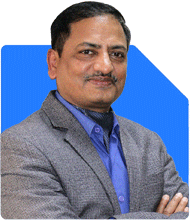Investing 1 Cr in Equities: PMS vs. AIF?
Ramalingam Kalirajan |10872 Answers |Ask -Follow
Mutual Funds, Financial Planning Expert - Answered on Nov 26, 2024
He has an MBA in finance from the University of Madras and is a certified financial planner.
He is the director and chief financial planner at Holistic Investment, a Chennai-based firm that offers financial planning and wealth management advice.... more

Hello Sir, I am going to receive sum of 1 Cr in coming months which I want to invest in equities through PMS or AIF. Since minimum investment for PMS is 50 lakh and for AIF 1 Cr. Should I invest in 2 PMS of different strategies or 1 AIF?
Understanding PMS and AIF
Portfolio Management Services (PMS):
PMS provides customised equity portfolios managed by professional portfolio managers. The minimum investment is Rs 50 lakh, allowing investors to personalise strategies.
Alternative Investment Funds (AIFs):
AIFs pool funds from investors to invest in various asset classes, such as equities, private equity, or structured debt. A minimum investment of Rs 1 crore is required.
Both options cater to high-net-worth individuals and offer sophisticated strategies.
Comparative Analysis of PMS and AIF
PMS Advantages
Customisation: Tailored strategies to suit individual risk profiles and objectives.
Transparency: Direct holding of stocks in the investor's demat account ensures visibility.
Flexibility: Easy to monitor and switch strategies within the PMS framework.
AIF Advantages
Diverse Strategies: Offers access to unique investment themes and asset classes unavailable in traditional portfolios.
Professional Expertise: Managed by experienced teams using advanced research and techniques.
Potentially Higher Returns: Targets absolute returns, often uncorrelated to the broader markets.
PMS Limitations
Concentration Risk: Limited to equity-focused investments, potentially leading to higher volatility.
Higher Costs: Management fees, performance-linked fees, and transaction charges can reduce returns.
AIF Limitations
Liquidity Constraints: Investments are typically locked for a fixed tenure, reducing flexibility.
Complex Structures: Strategies may be intricate and difficult to understand for many investors.
Taxation Challenges: Income generated is taxed as per the fund’s structure, potentially reducing post-tax returns.
Investment Strategy: 2 PMS or 1 AIF?
Choosing 2 PMS Strategies
Diversification Within Equity: Select different PMS providers offering varied investment philosophies. For example, one can focus on growth stocks and the other on value investing.
Greater Control: You can monitor and rebalance each PMS portfolio individually.
Flexibility: Exit options are relatively simpler, allowing quicker adaptation to market changes.
Choosing 1 AIF
Broader Asset Diversification: AIFs often provide access to non-traditional assets, which can diversify risks.
Simpler Management: Managing a single AIF portfolio may be easier than coordinating two PMS accounts.
Innovative Strategies: AIFs may invest in pre-IPO opportunities or hybrid models, offering unique growth avenues.
Assessing Risk Appetite and Investment Horizon
Short-Term Goals (1-5 years): PMS is better suited, given its flexibility and liquidity.
Long-Term Goals (5+ years): AIFs could outperform due to their sophisticated strategies and compounding benefits.
Risk Tolerance: If you can handle high volatility, PMS focusing on equities works well. If you prefer risk-mitigated returns, AIFs may be better.
Tax Implications
PMS Taxation: Gains from PMS investments are taxed as per individual capital gains rules. Long-term capital gains (LTCG) on equities exceeding Rs 1.25 lakh attract 12.5% tax. Short-term capital gains (STCG) are taxed at 20%.
AIF Taxation: Tax treatment depends on the fund structure. Income could be taxed at the fund level or passed through to investors, affecting post-tax returns.
Cost Considerations
PMS Costs: Higher management fees and potential performance-linked fees reduce effective returns.
AIF Costs: Typically, AIFs charge even higher management and administrative fees, especially for niche strategies.
Both options require careful assessment of costs versus potential returns.
Recommendations
If Liquidity is Crucial: Opt for 2 PMS accounts with varied strategies.
If You Seek Innovation: Choose 1 AIF to explore unique and diverse investment opportunities.
Balanced Approach: Split Rs 1 crore between 2 PMS accounts, provided both align with your financial goals.
Final Insights
Evaluate PMS and AIFs based on your financial objectives, risk appetite, and time horizon. Consult with a Certified Financial Planner to design a comprehensive strategy. Ensure your portfolio aligns with your broader financial plan.
Best Regards,
K. Ramalingam, MBA, CFP,
Chief Financial Planner,
www.holisticinvestment.in
https://www.youtube.com/@HolisticInvestment
You may like to see similar questions and answers below
Sanjeev Govila | Answer |Ask -Follow
Financial Planner - Answered on Jun 16, 2023
Ramalingam Kalirajan |10872 Answers |Ask -Follow
Mutual Funds, Financial Planning Expert - Answered on May 01, 2024
Ramalingam Kalirajan |10872 Answers |Ask -Follow
Mutual Funds, Financial Planning Expert - Answered on Oct 17, 2024
Ramalingam Kalirajan |10872 Answers |Ask -Follow
Mutual Funds, Financial Planning Expert - Answered on Oct 24, 2024
Milind Vadjikar | Answer |Ask -Follow
Insurance, Stocks, MF, PF Expert - Answered on Oct 18, 2024
Radheshyam Zanwar |6735 Answers |Ask -Follow
MHT-CET, IIT-JEE, NEET-UG Expert - Answered on Dec 06, 2025
Dr Nagarajan J S K |2576 Answers |Ask -Follow
NEET, Medical, Pharmacy Careers - Answered on Dec 06, 2025
Mihir Tanna |1090 Answers |Ask -Follow
Tax Expert - Answered on Dec 06, 2025
Ramalingam Kalirajan |10872 Answers |Ask -Follow
Mutual Funds, Financial Planning Expert - Answered on Dec 06, 2025
Radheshyam Zanwar |6735 Answers |Ask -Follow
MHT-CET, IIT-JEE, NEET-UG Expert - Answered on Dec 06, 2025
Radheshyam Zanwar |6735 Answers |Ask -Follow
MHT-CET, IIT-JEE, NEET-UG Expert - Answered on Dec 06, 2025
Radheshyam Zanwar |6735 Answers |Ask -Follow
MHT-CET, IIT-JEE, NEET-UG Expert - Answered on Dec 06, 2025
Dr Dipankar Dutta |1837 Answers |Ask -Follow
Tech Careers and Skill Development Expert - Answered on Dec 05, 2025
Dr Shyam Jamalabad |108 Answers |Ask -Follow
Dentist - Answered on Dec 05, 2025
Dr Shyam Jamalabad |108 Answers |Ask -Follow
Dentist - Answered on Dec 05, 2025




























